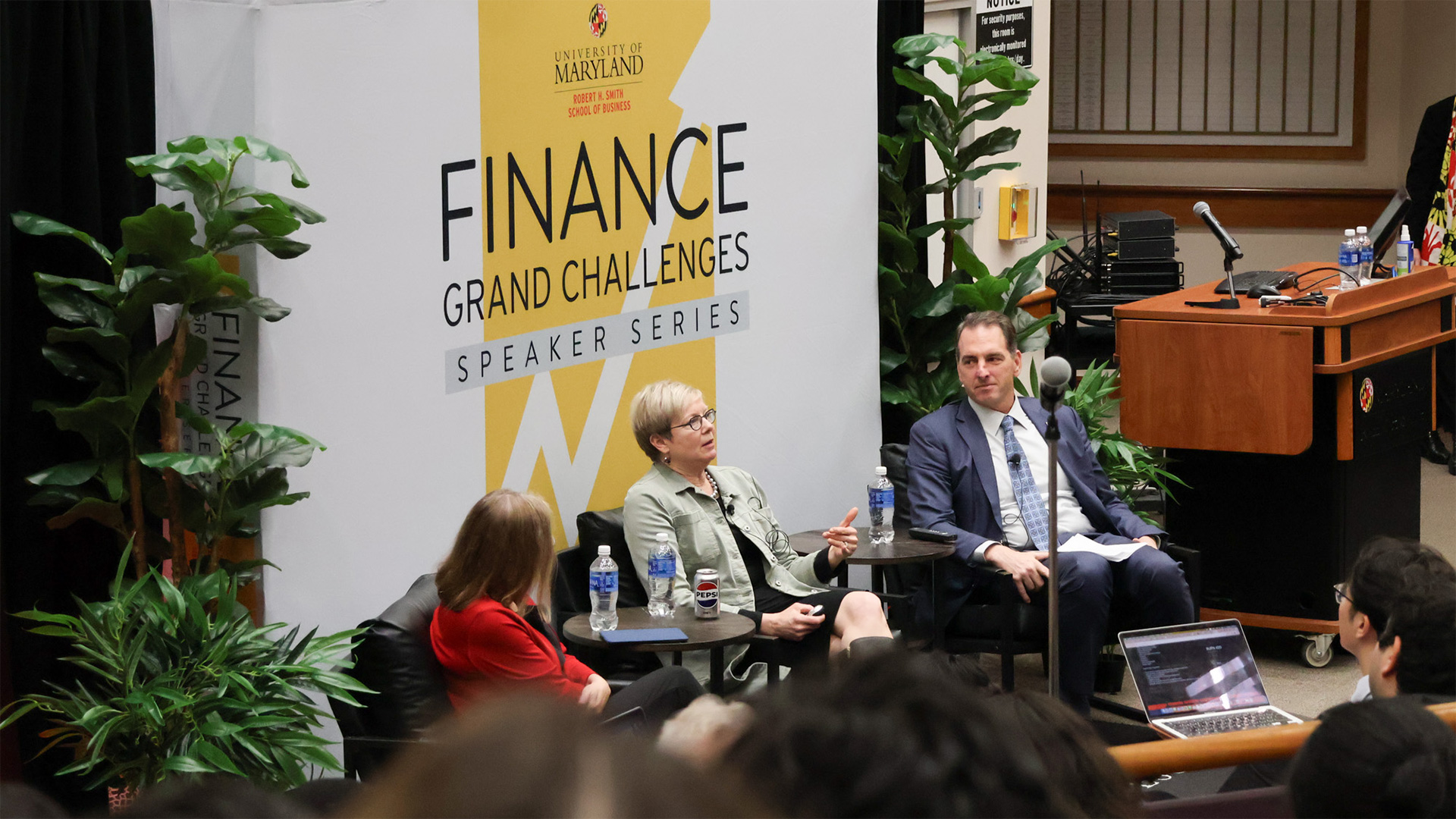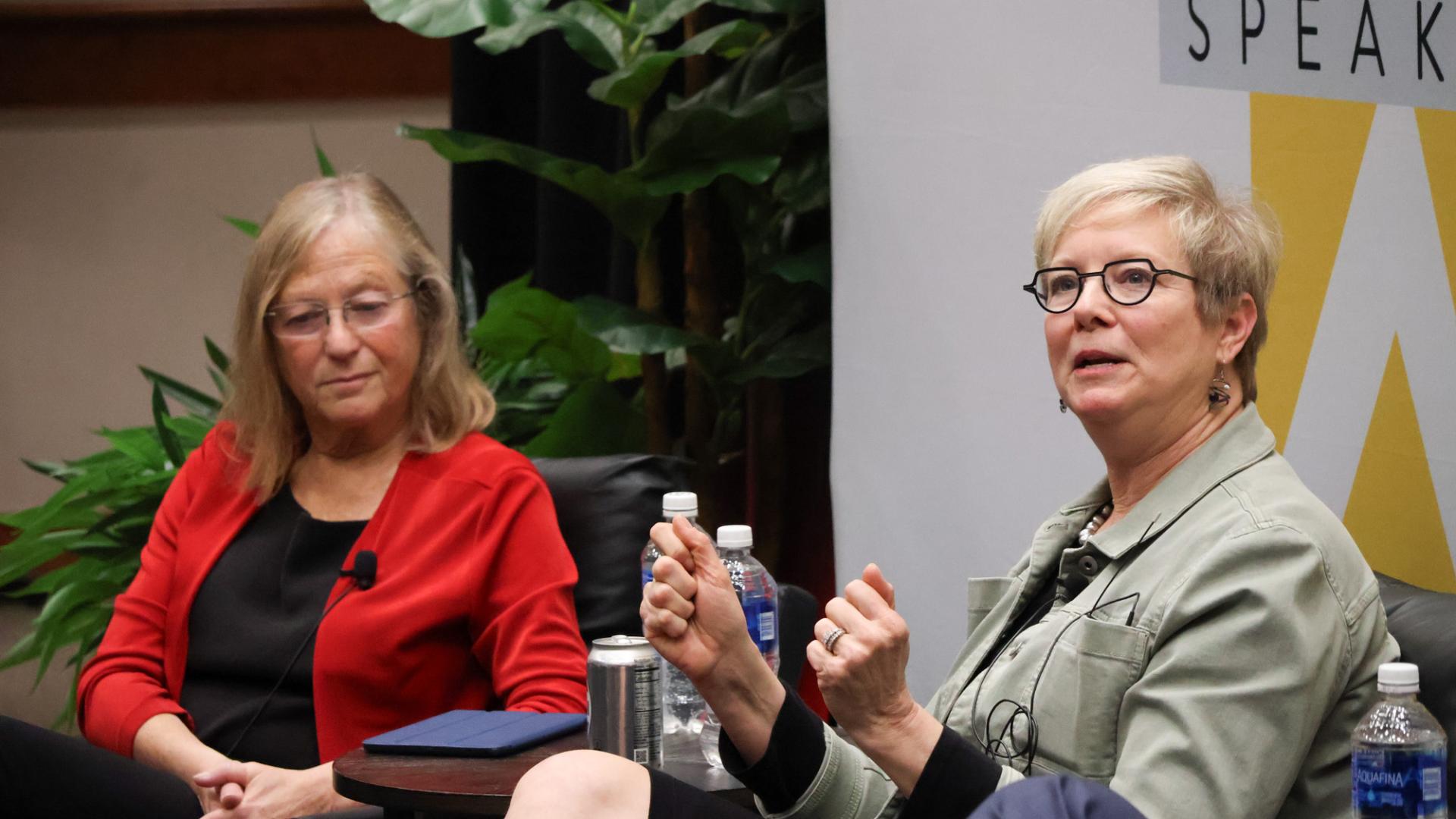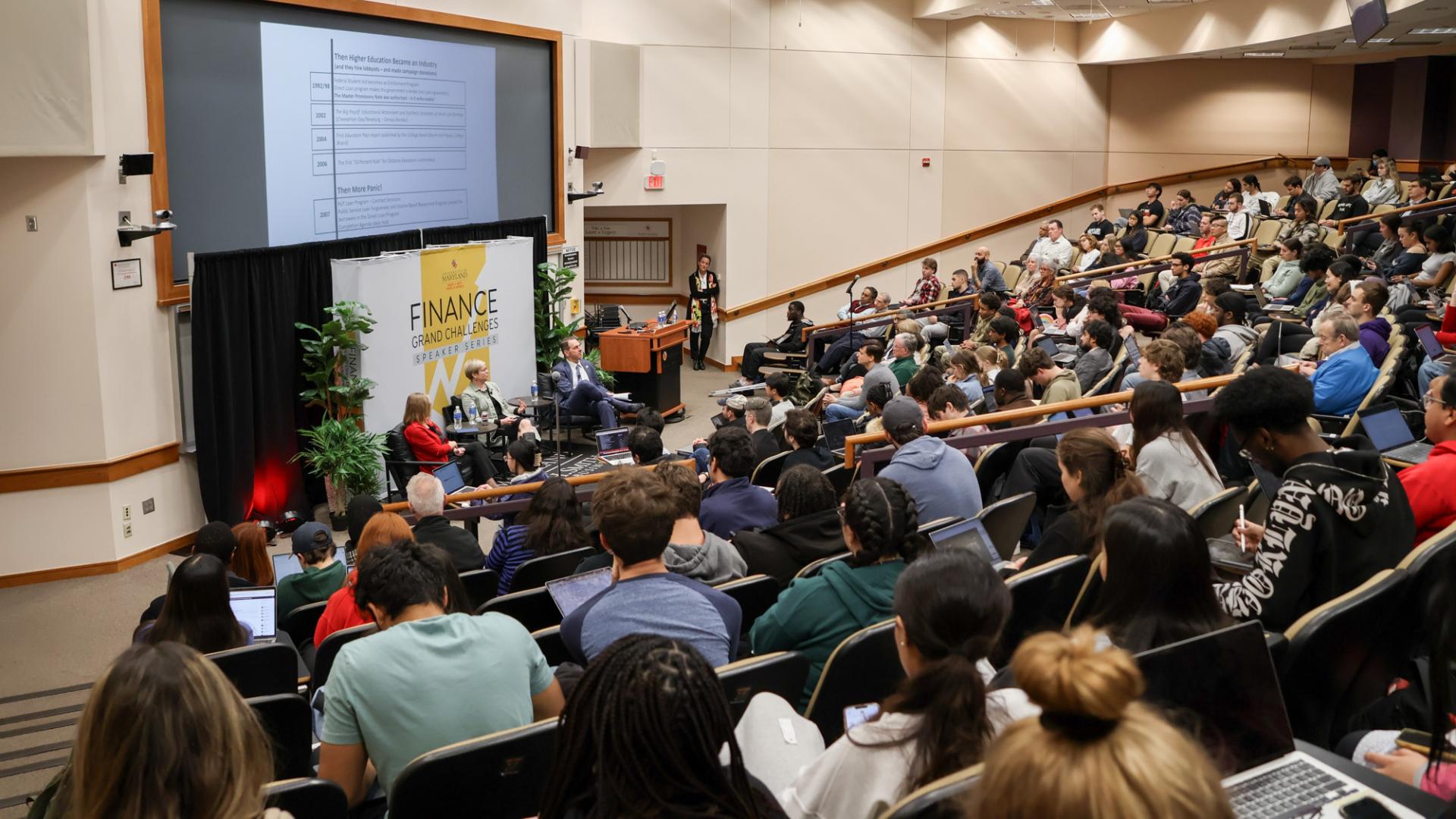
Rapidly increasing tuition rates at higher education institutions over the last several decades have resulted in a big problem—one worth $1.65 trillion in financial aid debt for millions of students and their families. Now policymakers are asking: How did we get here, and what equitable solutions exist to help alleviate the financial burden of higher education?
Those questions served as the backdrop of the latest installment in the Finance Grand Challenges Speakers Series at the University of Maryland’s Robert H. Smith School of Business. Tuesday’s event presented a candid, nonpartisan discussion on the pros and cons of student loan forgiveness and offered an examination of why these loan balances have grown.
The event series, presented by the Smith School’s Office of Executive Education, examines the nation’s most pressing economic and financial challenges. Running monthly through May, it brings renowned academic, industry and government professionals to the UMD campus, including White House appointees, Treasury department officials and widely published scholars.
Michael Faulkender, Dean’s Professor of Finance and former assistant secretary for economic policy at the U.S. Treasury Department, served as host and moderator of the event. He was joined by Sandy Baum, a nonresident senior fellow at the Urban Institute and professor emerita of economics at Skidmore College, and Diane Jones, former Acting Undersecretary at the Department of Education for Postsecondary Education.
With the event’s opening remarks, Smith School Dean Prabhudev Konana lauded the series for enabling students to think critically about society’s grand challenges, upholding the values of the school’s strategic plan and fostering an environment that encourages everyone to participate in these crucial conversations.
“In the spirit of academia, we present these civil conversations to the student body as another way to help them continue growing as thought leaders,” said Konana. “We ask them to look at the evidence, listen to different perspectives and draw conclusions. That’s the type of intellectual curiosity that we seek to provide with this event.”
UMD Senior Vice President and Provost Jennifer King Rice, in her remarks before the discussion, noted the vital role the university plays in training the next generation of professionals and expressed her appreciation to the Smith School for leveraging its network of experts to identify ways to make higher education more accessible and affordable for all students.
“We're committed at this university to being at the forefront of dialogue and accelerating solutions to some of the world's most pressing problems,” said King Rice. “This third event in the series is a great example of that commitment, and I'm grateful that the Smith School is taking on this responsibility.”
Setting the stage for the conversation, Faulkender noted the roughly 6.25% annual increase in tuition and fees across two and four-year institutions and graduate schools since 1980. During that time, the consumer price index of all goods and services has risen at a 3.1% yearly rate.
“Compounding that differential over those 43 years, what that means is that while the average good or service has increased 268% over that period, college tuition has risen 1244%,” said Faulkender. “As a result, more and more students and their families are seeking financial assistance to attend college.”
Despite that stark difference, Faulkender added that college attainment continues to be strongly correlated with employment and income results. That correlation results in families' willingness to take on the financial burden of tuition. It contributes to millennial trends of delaying or forgoing marriage and being more likely to live at home longer.
Part of the issue also lies with the nature of student loans, Faulkender said. Student loan borrowers are typically between the ages of 17-19 at the time of their first loan. Those students usually do not have credit histories and do not possess collateral they can post against the amount borrowed.
“In that way, it’s very different from a car or mortgage loan, and that means there may be no interest rates at which a lender is willing to lend to them,” said Faulkender. “That form of market failure potentially generates a unique role for government intervention that doesn't exist in other kinds of borrowing.”
In her remarks, Baum shared several questions that policymakers should consider when creating student loan forgiveness solutions: How much are individual students borrowing? Who owns the debt? Who is making the payments, and who would benefit from debt forgiveness?
Wiping away the debt outright only serves as a temporary fix given that more students will enroll in colleges and they will start the borrowing cycle over again, she said. In that sense, this issue is not so much about access to higher education but more about people who have already had their education and are paying these loans.
“Roughly 60% of federal student loan debt is held by people in the top 40% of income-earning households,” said Baum. Because of the increasing use of income-driven repayment, “monthly payments are even more concentrated among high-income people because you'll have higher payments if you have a higher income.”
According to Baum, another considerable distinction about student loans is that today’s students are not just borrowing to pay their tuition and fees. They’re “borrowing to pay their living expenses as well.”
Plenty of students have their tuition covered by grants, yet the debt amounts of students not paying tuition are not far below the debt amounts of those who are paying tuition, she said. That finding alone suggests that the issue is much more complicated than solely attributing it to tuition hikes. Today, state funding hasn’t increased rapidly enough to maintain funding for increased student enrollment.
“It goes up and down. It’s a cyclical process. When states don’t have enough money, they cut back, but where can you cut?” said Baum. “States cut back by reducing money given to colleges, and in turn, the colleges raise their tuition.”
On the other hand, Jones established interest rates on student loans as the fundamental problem. One example she cited was a graduate student who graduated with $120,000 owed in principal and $24,000 more in capitalized interest. That student is then placed on a 30-year payment plan with a monthly payment of $1,000, $900 of which is allocated to interest during the first ten years.
“Almost ten years later, you’ve paid $120,000 and still owe $126,000. This is why students want loan forgiveness,” said Jones. “However, I do not believe we should ever forgive the principal because you took it and spent that money, but the interest is a problem. Why should one kid pay three times as much to go to college than someone else who didn’t take out loans?”
One potentially fair approach, Jones said, is to follow the payment model of Scandinavian countries—graduates are given as many years as it takes to pay their principal costs, but they will never pay more than 150% of what was borrowed.
“At the end of the day, if you have a borrower of over 30 years who has paid $380,000, that’s money that could have gone towards a house,” said Jones. “These loans are straining the people who are supposed to possess economic buying power. Something will have to change.”
Finance Grand Challenges Speaker Series
The Finance Grand Challenges Speaker Series, presented by the Smith School’s Office of Executive Education, is the school’s latest example of its strategic imperative toward addressing society’s grand challenges. The first event in the series featured Congressional Budget Office (CBO) Director Phillip Swagel and ExxonMobil Chief Economist Tyler Goodspeed in a discussion on the federal budget.
Upcoming events will bring additional luminaries to campus. In May, U.S. Senator Ben Cardin, Chair of the Senate Small Business and Entrepreneurship Committee, and Linda McMahon, Former U.S. Administrator of the Small Business Administration, will join the series to discuss entrepreneurship and small business.
Media Contact
Greg Muraski
Media Relations Manager
301-405-5283
301-892-0973 Mobile
gmuraski@umd.edu
About the University of Maryland's Robert H. Smith School of Business
The Robert H. Smith School of Business is an internationally recognized leader in management education and research. One of 12 colleges and schools at the University of Maryland, College Park, the Smith School offers undergraduate, full-time and flex MBA, executive MBA, online MBA, business master’s, PhD and executive education programs, as well as outreach services to the corporate community. The school offers its degree, custom and certification programs in learning locations in North America and Asia.

